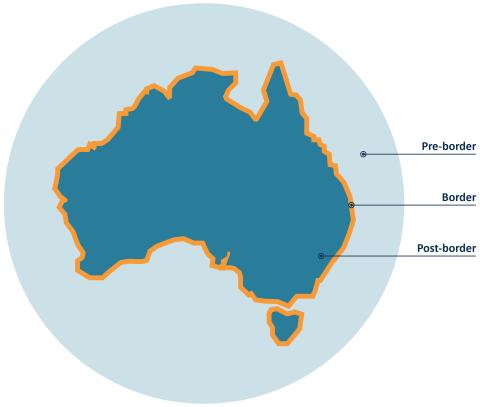Exotic invasive species cause significant environmental damage by outcompeting our wildlife, degrading habitats and threatening Australia’s biodiversity. They can impact our agricultural productivity and our way of life.
Environmental biosecurity protects Australia’s plants, animals and eco-systems from the destructive impacts of invasive species. It is part of Australia’s broader biosecurity system that also protects our animal, plant and marine industries.
Discover why environmental biosecurity is everyone’s business
How it works

Australia is fortunate to be a relatively isolated, island continent. This has allowed us to stay free of some the world’s most damaging pests. Australia’s biosecurity system strives to keep those pests out, for the sake our industries, our environment and our way of life.
Many people will interact with our biosecurity system at the border. For instance, they might see detector dogs at the airport sniffing out pests or have incoming mail packages screened for biosecurity risks. However, our biosecurity system goes beyond what happens at the border. In fact, it’s a multi-layered system.
- Pre-border biosecurity includes work with neighbouring countries, international bodies and importers to stop pests before they reach our border.
- Border biosecurity includes inspections, screening and quarantine to stop pests entering Australia, as well as stiff penalties for those who break the rules.
- Post-border biosecurity includes monitoring for pests and diseases in Australia and responding if we detect them within our borders.
Environmental biosecurity
Environmental biosecurity strives to protect Australia’s environment, including our native plants and animals, from invasive species and exotic diseases. This sometimes overlaps with biosecurity for our plant, animal and marine industries. For instance, some diseases impact farmed animals as well as wildlife. However, environmental biosecurity also protects our environment and the way of life it allows us for its own sake.
The Environmental Biosecurity Office works across all parts of the system, advocating for strong environmental biosecurity. Led by the Australian Chief Environmental Biosecurity Officer (ACEBO), the office is improving capability of the whole system to deal with exotic environmental pests.
We look beyond Australia’s border so we can prepare for environmental pests currently impacting our neighbours. We prioritise risk species through the Exotic Environmental Pest List. We invest in research and innovation to tackle pests before, at and inside our borders through our Environmental Biosecurity Project Fund.
If pests are detected within our borders, the office participates in response activities. Where exotic environmental pests establish, we try to limit their spread and impact. We work together with government partners, non-government organisations and First Nations communities to support on-ground initiatives. The Environmental Biosecurity Office coordinates control of some priority established animal pests and weeds.
A shared responsibility
The commonwealth manages many aspects of environmental biosecurity. But responsibility lies with us all. States and territories, industry and the community all play a role. For instance, states and territories often take a leading role during a biosecurity outbreak within their borders. They are also responsible for domestic regulations and enforcement. Environmental organisations may help foster biosecurity awareness or fund research. Research organisations might participate in surveillance activities. But all these groups, as well as the community, are responsible for complying with biosecurity measures that protect our unique natural resources.
See how we work with state and territory governments and with industry during an outbreak. Or use these resources to understand more about Australian biosecurity.
Report an exotic environmental pest
You can report an exotic environmental pest at the Outbreak website.
This site also contains up-to-date information on current biosecurity outbreaks.
